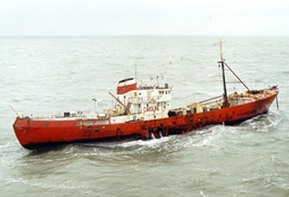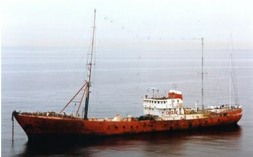© 2014-


Radio Caroline 1980s - History (7)
1987
A significant piece of British legislation affecting offshore radio stations was passed in May 1987. The Territorial Sea Act extended the then three mile British territorial limit to twelve miles and, as a consequence, the two radio ships positioned off the coast (Ross Revenge and Laser Hot Hits’ Communicator) were forced to find new anchorages further out to sea.
The legislation was not primarily directed at the offshore radio stations, it was enacted to bring Britain in line with most other European countries and to assist HM Customs and Excise in their battle against smuggling, particularly in the area of drugs enforcement.
The (by then silent) Communicator was the first radio ship to move in May 1987, although the Act’s provisions did not come into effect until 1st October 1987. On 10th June 1987 Radio Caroline and Radio Monique announced that the Ross Revenge had moved and was at an anchorage in the South Falls Head, a position two miles outside the new territorial limit but in much more exposed waters as well as nearer to the main shipping lanes.
As well as difficulties brought about by the need to relocate due to the Territorial Sea Act Radio Caroline was also dealt another blow in mid 1987 when Panama's Directorate of Consular and Maritime Affairs announced that it was increasing maritime safety standards and all ships over 20 years old wishing to remain registered would have to be re-
Throughout the summer of 1987 transmissions on both Radio Caroline and Radio Monique continued to become more and more reliable, in technical terms, and there were fewer breakdowns.
However, during the night of 15/16th October 1987 a hurricane swept acros s south east England, causing major destruction and loss of power supplies throughout a huge area. Radio Caroline and Radio Monique were programming normally until 7.30am on 16th October when they were both forced to close for about an hour due to problems with the aerial mast arcing. Both stations returned later and broadcasts continued throughout the day, although the arcing problem persisted repeatedly tripping the transmitter, so at 3.00pm it was decided to close both stations. Nevertheless the Ross Revenge had survived the hurricane, which had damaged or grounded other vessels which had not sought shelter.
s south east England, causing major destruction and loss of power supplies throughout a huge area. Radio Caroline and Radio Monique were programming normally until 7.30am on 16th October when they were both forced to close for about an hour due to problems with the aerial mast arcing. Both stations returned later and broadcasts continued throughout the day, although the arcing problem persisted repeatedly tripping the transmitter, so at 3.00pm it was decided to close both stations. Nevertheless the Ross Revenge had survived the hurricane, which had damaged or grounded other vessels which had not sought shelter.
On 24th November 1987, despite a strong north easterly gale starting to buffet the Ross Revenge, programming continued as normal throughout the day on both Caroline 558 and Radio Monique. The storm continued throughout the evening and night, increasing in intensity and whipping up heavy seas which caused the radio ship to pitch and roll.
Radio Monique closed as normal at 7.00pm with the usual announcement that the station would return at 5.00am the following morning. Caroline 558 continued to broadcast, but left the air suddenly at 2.51am on 25th November, when aerial feeder cables split.
About an hour and a half later DJs and crew on the Ross Revenge heard a huge crash and went on deck to discover to their horror that the ship's massive 300' (91m) aerial tower had broken away at deck level and fallen into the sea. Luckily the tower had collapsed over the starboard side of the ship and not fallen forwards or backwards onto the vessel where it would have caused major damage and possible injuries.
At first light on 25th November 1987 the remains of the mast hanging over the side of the Ross Revenge, which were causing the vessel to list slightly, were cut away and the full extent of other damage caused by the falling mast was revealed when the crew set about cleaning up the rest of the ship.
With both stations on the Ross Revenge now off the air the Caroline organisation desperately needed to find a way of earning revenue and it was clear that an emergency replacement aerial system would have to be constructed at sea to enable some sort of signal to be transmitted from the Ross Revenge.
Incredibly this was achieved in appalling weather conditions before the end of November 1987 when station engineer Peter Chicago constructed a temporary wire aerial array, strung between the ship's original fore mast and the funnel. Using this array Caroline 558 was able to return to the air by 3rd December 1987, but with a very weak signal. Broadcasts gradually increased over the following week, but by 11th December 1987 there were only two DJs left on board the Ross Revenge yet they managed to provide a 12 hour service between 6.00am-
1988
Bad weather persisted in the North Sea throughout the early days of 1988. On Radio Caroline broadcasting hours were somewhat erratic until after 7th January when a regular 6.00am-
During those nine da ys silence four 15' (4.6m) sections of telescopic mast had been erected at the stern of the Ross Revenge and the front mast had been extended to 90' (27m) by welding sections of copper pipe on top of the existing structure. Using this new aerial Caroline 558 was able to return to the air with a stronger signal than was possible with the temporary array, but it still did not provide a facility for a separate Dutch language station to broadcast simultaneously. The reinstitution of a revenue earning Dutch language service was of utmost importance to Caroline, but in the absence of adequate technical facilities another approach was tried -
ys silence four 15' (4.6m) sections of telescopic mast had been erected at the stern of the Ross Revenge and the front mast had been extended to 90' (27m) by welding sections of copper pipe on top of the existing structure. Using this new aerial Caroline 558 was able to return to the air with a stronger signal than was possible with the temporary array, but it still did not provide a facility for a separate Dutch language station to broadcast simultaneously. The reinstitution of a revenue earning Dutch language service was of utmost importance to Caroline, but in the absence of adequate technical facilities another approach was tried -
Some shortwave tests had been made in November 1985 and further shortwave broadcasts from the Ross Revenge took place in February, March and April 1988 on a number of frequencies generally relayed the normal Caroline 558 programmes.
Following successful completion of these tests a new station was launched from the Ross Revenge on 1st May 1988 on shortwave using the call sign World Mission Radio (WMR) broadcasting a range of sponsored religious programmes in Dutch and English.


Click on picture to enlarge
Ross Revenge shortly after the collapse of the aerial tower, November 1987
The temporary aerial constructed on board Ross Revenge early in 1988
Spin Magazine



Video taken aboard Ross Revenge as the aerial mast collapses and scenes of the damage caused, November 1987
Shortwave tests, 6th March 1988, Mike Watts

The Ross Revenge filmed from the tender Bellatrix 1987 (before the mast collapse in November)

History
Key Dates
Ship and Location
Technical
Staff
Programmes






London Evening Standard
25th November 1987
Treasure Chest





Back to Britain Gallery


Back to Radio Caroline 1980s
